You don’t need to spend hours doing ab workouts to get a six-pack.
In fact, doing just a handful of ab exercises each week is plenty. The only caveat is that you have to be doing the right ab exercises
That’s where most people go wrong.
They churn through cardio-like ab workouts filled with mountain climbers, standing side crunches, “hundreds,” and the like.
While these movements may burn a few calories, they don’t allow you to train your abs with extra weight or get progressively stronger over time, so they’ll never help you carve out a defined, muscular midsection.
In this article, you’ll learn what’s really required for building shredded abs. You’ll discover which muscles you need to train, the best 3 types of ab exercises for sculpting your entire midriff, evidence-based ab workouts for size and strength, and more.
Table of Contents
+
Ab Anatomy
When people refer to the “abs,” they’re typically talking about all the muscles that wrap around your midsection, including:
- Rectus abdominis
- Transverse abdominis
- Obliques (internal and external)
Here’s how they look:
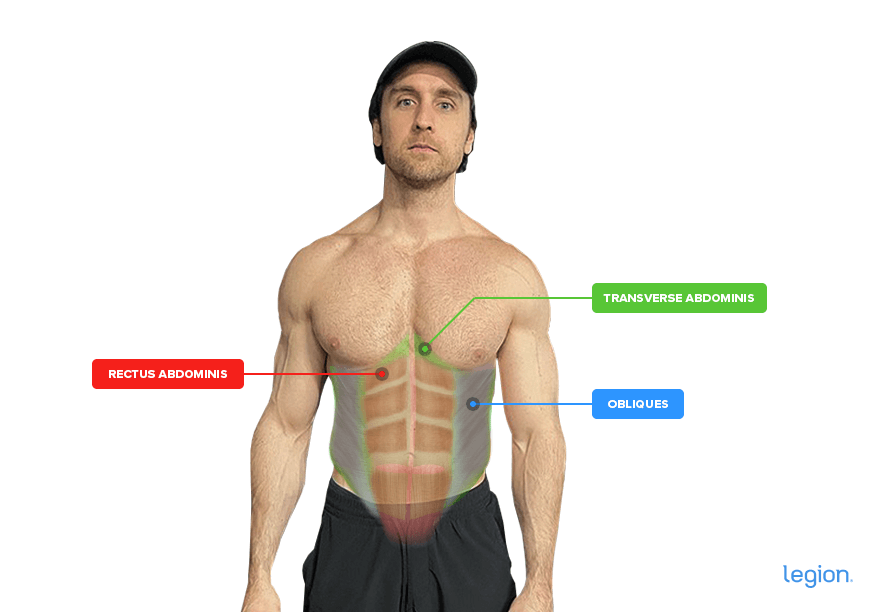
Grasping the anatomy of your abs helps you understand which areas you need to train to ensure you develop a balanced, defined midsection.
The 3 Best Ab Exercises for a Defined 6-Pack
The abs have two primary functions: Stabilizing and flexing the spine. In other words, they keep your torso upright and stable, and they bring your chest toward your hips (or vice versa).
To train them properly, you should focus on ab exercises that strengthen both of these movements. Here’s what works best:
- Leg Lifts: Exercises that bring your thighs toward your chest emphasize the lower abs. Hanging exercises are particularly effective, with some of the best options being hanging leg raises, captain’s chair leg raises, and lying leg raises.
- Sit-ups: Sit-up-style exercises that bring your chest to your knees emphasize your upper abs. Beginners often start with sit-ups, but that doesn’t mean they’re only for novices—variations like decline or weighted ab sit-ups are plenty challenging for experienced gymgoers. Top-tier examples include cable crunches, sit-ups, and decline sit-ups.
- Spine Stabilization: Strengthening the muscles responsible for spine stabilization typically involves rotational, anti-rotational, and isometric (static holding) exercises. The oblique cable crunch, air bicycle, and ab wheel rollout are among my favorites.
We’ll be looking at how to fit these exercises into effective ab workouts soon, but first it’s important to understand why weighted ab exercises are essential.
The Importance of Weighted Ab Exercises
To build a strong, shredded core, your ab workouts shouldn’t only include the three types of exercises mentioned earlier—they should incorporate weighted ab exercises whenever possible, too.
Doing ab exercises with weights allows you to progressively overload your ab muscles, which is crucial for training them effectively and increasing their size and strength.
And by the way, this applies to both ab workouts for men and women.
Despite what some fitness “gurus” say, weighted ab exercises won’t give women a blocky or wide waist.
Take, for example, the women in my Thinner Leaner Stronger and body transformation coaching programs. They regularly do weighted abdominal (and compound) exercises, and the results speak for themselves:
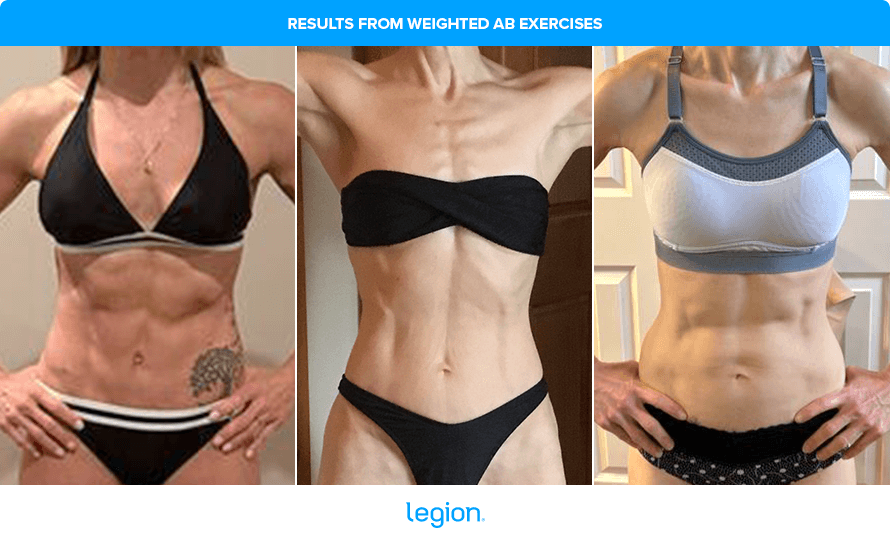
The Best Weighted Ab Exercises
Each exercise on this short list allows you to progressively overload your core, making them perfect for sculpting a six-pack:
- Cable crunch
- Oblique cable crunch
- Weighted hanging leg raise
- Weighted captain’s chair leg raise
- Weighted sit-up
- Decline weighted sit-up
The 3 Best Ab Workouts for Shredded Abs
These ab workouts for men and women contain all the best ab-shredding exercises. Give them a try and watch your core transform.
Ab Workout #1

1. Cable Crunch

- Adjust the pulley on a cable machine to the highest setting and attach the rope attachment.
- Facing the cable machine, grab one end of the rope in each hand and step back to support the weight.
- Kneel on the floor, pulling the rope down until both ends are in front of your forehead.
- Adjust your body so that your thighs are perpendicular to the floor and your shoulders are ahead of your hips.
- Without moving your arms or hips, pull your elbows to your thighs by rounding your spine.
- Reverse the movement and return to the starting position.
How to Progress: Use a weight that allows you to do at least 10 reps per set but not more than 20. Once you can do 20 reps with that weight, add 5 pounds and work up to 20 reps with that weight. Keep increasing the weight and reps in this manner.
2. Captain’s Chair Leg Raise
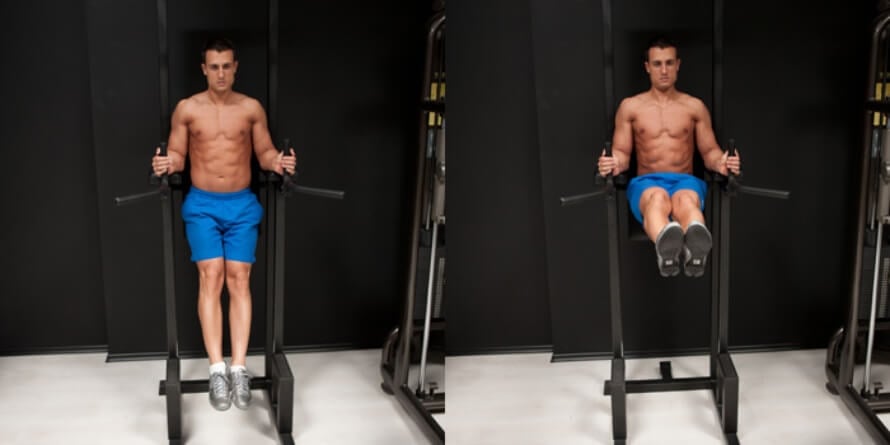
- Place your back against the back pad on a captain’s chair station, grab the handles, and rest your forearms on the arm pads.
- Support your body weight on your arms and let your feet hang straight down.
- With a slight bend in your knees, flex your abs and lift your legs up in an arc until your thighs are parallel to the ground.
- Reverse the movement and return to the starting position.
How to Progress: Start by aiming for 10 reps per set with no added weight. Once you can do 20 reps per set, hold a 5-pound dumbbell between your feet. When you reach 20 reps with that weight, increase the load by 5 pounds, and keep progressing in this way until the dumbbell becomes unwieldy—usually around 20-to-30 pounds. At that point, switch to a more challenging ab exercise, like the weighted hanging leg raise.
3. Air Bicycle
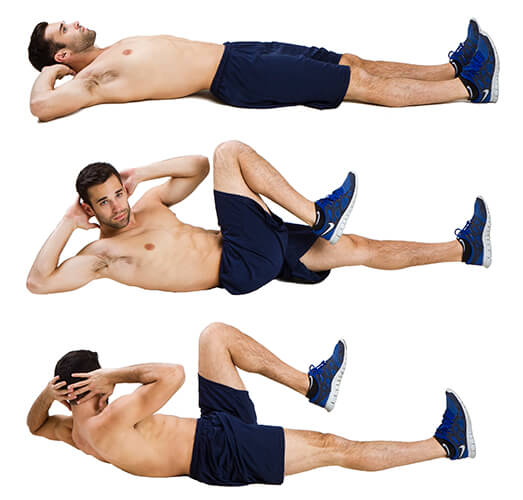
- Lie on your back with your fingers touching your temples or the back of your head.
- Lift your legs off the ground and bend your knees to 90 degrees, so your shins are parallel with the ground.
- Flex your abs and lift your torso a few inches off the ground.
- Straighten your right leg, keeping your foot a couple of inches off the floor, while twisting your torso so your right elbow touches your left knee.
- Bring your right leg back to the starting position and straighten your left leg, twisting your torso so your left elbow touches your right knee.
How to Progress: Once you can do 30 reps (total) in all 3 sets, switch to the oblique cable crunch or ab wheel rollout.
Ab Workout #2
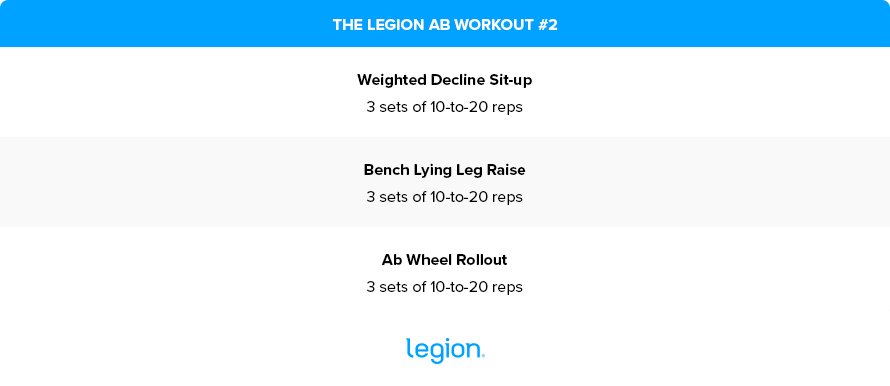
1. Decline Weighted Sit-up
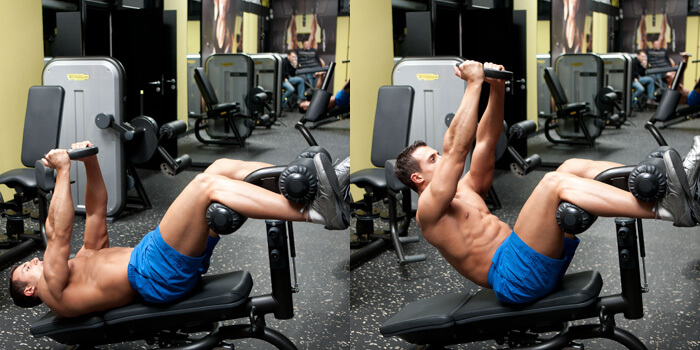
- Lie on a sit-up bench with your feet wedged under the foot pads.
- Using both hands, hold a weight plate directly above your chest with your arms straight (or hold the weight against your chest with your arms crossed).
- Keeping your arms perpendicular to the floor and your back flat, use your ab muscles to lift your chest toward the ceiling until your lower back comes off the bench.
- Reverse the movement and return to the starting position.
How to Progres: You may not need added weight at first, but once you’re strong enough, start by aiming for 10 reps per set while holding a 5-pound plate or dumbbell. When you can comfortably do 20 reps with the added weight, increase it by 5 pounds and continue progressing in this manner.
2. Lying Leg Raise

- Lie on a flat bench with your butt at the bottom of the bench, your arms at your sides, and your hands gripping the sides of the pad for support.
- Lift your legs so that they’re parallel with the floor and bring your feet together.
- Using your lower abs, lift your legs in an arc toward the ceiling until they are vertical or slightly past vertical, and your lower back lifts off the bench.
- Reverse the movement and return to the starting position.
How to Progress: Once you can do 20 reps in all 3 sets, switch to the captain’s chair leg raise.
3. Ab Wheel Rollout
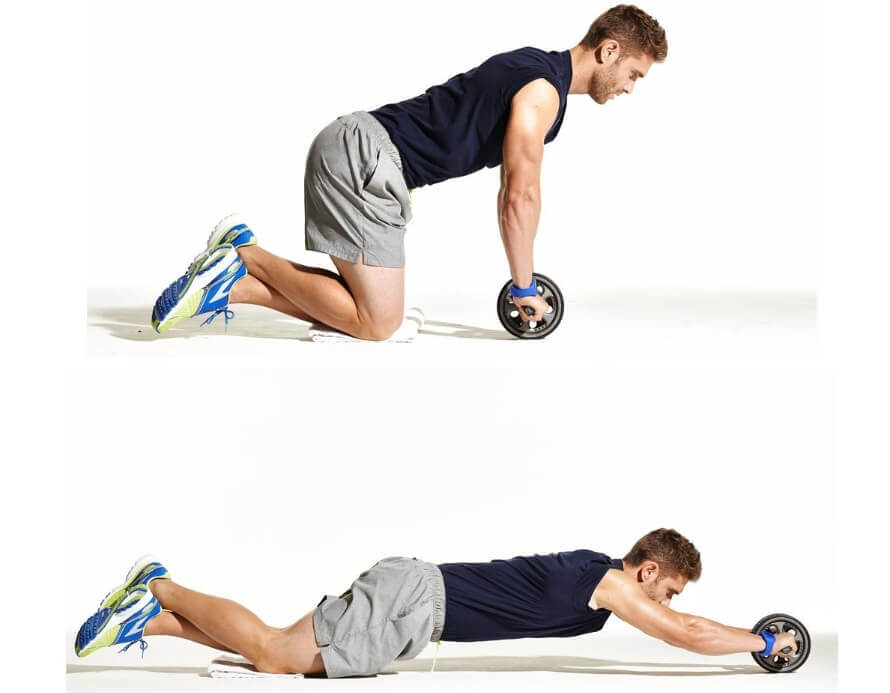
- Kneel on the floor with an ab wheel in front of you.
- With your arms fully extended, core braced, and back flat, grab the handles of the ab wheel and slowly roll the wheel away from you.
- Roll the wheel until your body is as close to parallel with the floor as possible.
- Roll yourself back to the starting position by flexing your abs.
How to Progress: Start by performing the exercise with your knees and feet on the floor. As you build strength, cross your feet and lift them a few inches to increase the difficulty. Once that becomes manageable, focus on slowing down each rep. When you’re able to do 3 sets of 20 slow rollouts with your feet elevated, it’s time to move on to a more advanced exercise.
Ab Workout #3
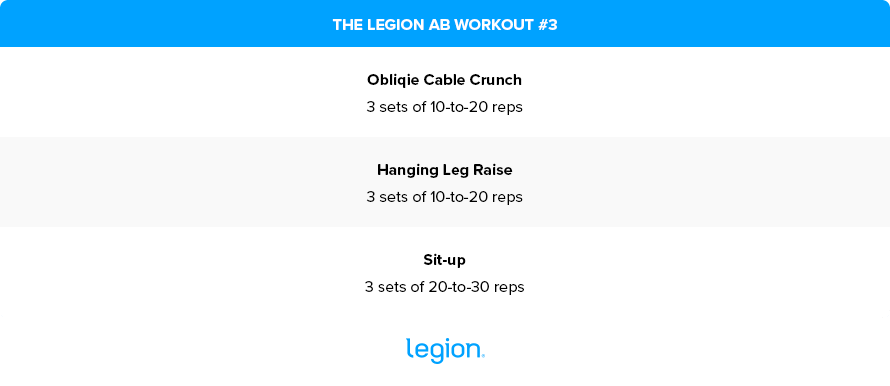
1. Oblique Cable Crunch
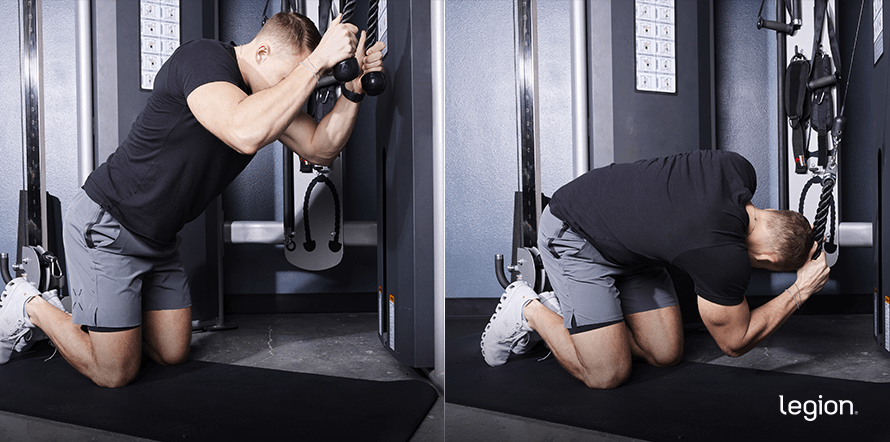
- Adjust the pulley on a cable machine to the highest setting and attach the rope attachment.
- Facing the cable machine, grab one end of the rope in each hand and take a step back to support the weight.
- Kneel on the floor, pulling the rope down until both ends are in front of your forehead.
- Adjust your body so that your thighs are perpendicular to the floor and your shoulders are ahead of your hips.
- Without moving your arms or hips, pull your right elbow to your left knee by turning your torso and rounding your spine.
- Reverse the movement, then repeat the process, pulling your left elbow to your right knee.
How to Progress: Use a weight that allows you to do at least 10 reps per set but not more than 20. Once you can do 20 reps with that weight, add 5 pounds and work up to 20 reps with that weight. Keep increasing the weight and reps in this manner.
2. Hanging Leg Raise
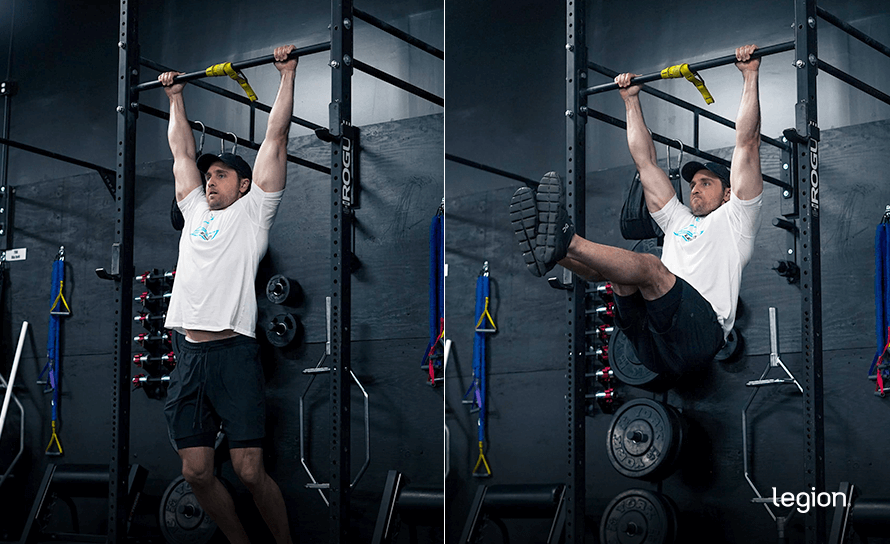
- Grip a pull-up bar with your palms facing away from you and slightly wider than shoulder-width apart, then lift your feet so that you’re hanging with your arms straight.
- While keeping your legs as straight as possible and without swinging your feet or knees, lift your feet toward the ceiling until your thighs are parallel with the floor.
- Reverse the movement and return to the starting position.
How to Progress: If you’re not yet strong enough to perform the exercise with straight legs, start by bending your knees and lifting them until your thighs are parallel to the floor. As you get stronger, gradually work toward straightening your legs.
Once you can do 20 reps per set with straight legs, add resistance by holding a 5-pound dumbbell between your feet. When you can do 3 sets of 20 reps with that weight, increase the load by 5 pounds. Continue progressing in this manner until the weight becomes too difficult to hold—typically around 20-to-30 pounds—and then switch to the cable crunch.
3. Sit-up
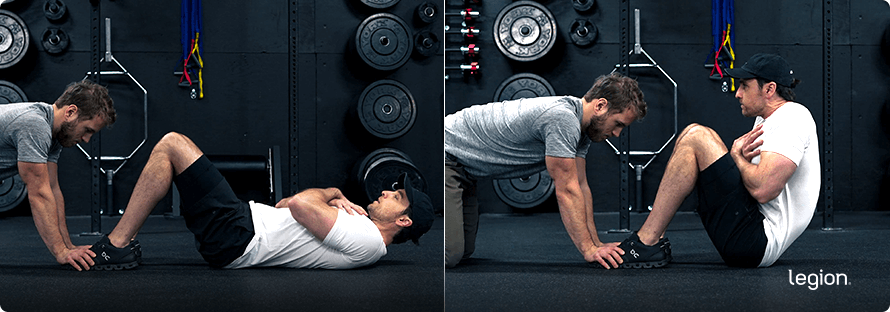
- Lie on your back with your knees bent.
- Plant your feet flat on the floor and wedge your toes underneath something heavy or have a training partner pin them down.
- Cross your arms over your chest or rest your hands against the back of your head (don’t pull on your neck, though).
- Curl your torso toward your knees until your back is perpendicular to the floor.
- Reverse the motion and return to the starting position.
How to Progress: If you’re new to sit-ups, aim for 20 reps per set with just your body weight. Once you can do 30 reps per set, perform the exercise holding a 5-pound plate or dumbbell against your chest. When you can do 30 reps per set with the added weight, increase it by 5 pounds and continue progressing in this manner.
How to Do the Ab Workouts
Structuring Your Ab Workout
You have three options for structuring your ab workouts:
- Circuit Training: Perform all three ab exercises back to back without resting between them. This is the fastest way to complete your ab workout, but the downside is that your performance may suffer since your abs won’t fully recover between sets. Use this method if you’re short on time but still want to get your ab workout in.
- Straight Sets: Do all sets of one exercise before moving on to the next. After each set, rest for 1-to-2 minutes. This approach delivers great results but takes the most time, as you’re resting between every set.
- Ab Supersets: To complete an ab superset, perform an exercise, immediately follow it with an ab exercise, then rest. This method balances efficiency and effectiveness, allowing you to maximize your workout time while still giving your abs sufficient recovery between sets. Here’s an example of a pull workout using ab supersets:
- Deadlift: 3 sets with 2-to-4 minutes rest between each set.
- Seated Cable Row + Oblique Cable Crunch: Perform each exercise back to back, then rest 2-to-3 minutes. Repeat for 3 supersets.
- Pull-up + Hanging Leg Raise: Perform each exercise back to back, then rest 2-to-3 minutes. Repeat for 3 supersets.
- Barbell Curl + Sit-up: Perform each exercise back to back, then rest 2-to-3 minutes. Repeat for 3 supersets.
Frequency
If you’re already doing a lot of heavy, compound weightlifting, one good ab workout per week is plenty. You can do this as a stand-alone session or tack it onto the end of one of your regular workouts (my preferred method).
If your training is isolation-exercise heavy, or if you want to prioritize ab development, do two ab workouts weekly on non-consecutive days.
When to Change Your Ab Workout
If you’re doing one ab workout per week, switch to a new workout every 8-to-10 weeks. For example, after 8-to-10 weeks of Ab Workout #1, move on to Ab Workout #2, stick with it for another 8-to-10 weeks, then switch to Ab Workout #3, and so on.
If you’re doing two ab workouts per week, you have two options:
- Stick with the same workout twice a week for 8-to-10 weeks. After that, switch to the next workout.
- Do Ab Workout #1 for your first workout of the week and Ab Workout #2 for your second. After 8-to-10 weeks, rotate Ab Workout #2 to your first workout and Ab Workout #3 to your second. Continue this pattern every 8-to-10 weeks.
Ab Workouts: Key Takeaways
Building a strong, defined six-pack doesn’t require endless hours of training or complicated routines.
What matters most is that you do ab exercises that train both key functions of the abs—flexing and stabilizing the spine—and allow you to employ progressive overload (weighted ab exercises are best for this).
You can easily integrate these exercises into your regular training, too. While there are a few ways to do it, incorporating ab supersets into 1-to-2 of your weekly workouts is the most time-efficient.
FAQ #1: Can you do ab workouts while pregnant?
Yes, studies show that ab exercises are safe for both mother and baby during pregnancy. Some evidence even suggests that strengthening your abs while pregnant may help reduce postpartum symptoms of diastasis recti.
FAQ #2: Do ab workouts burn belly fat?
No, ab workouts alone won’t burn an appreciable amount of belly fat. You can’t spot-reduce fat from specific areas of your body by training the muscles in those areas.
To lose belly fat, you need to maintain a calorie deficit. The best way to do this is with a combination of calorie-controlled dieting and strength training.
If you want help deciding the best diet and training program for you, take the Legion Diet Quiz and Training Quiz to get a custom-made diet and training plan in less than 60 seconds.
FAQ #3: How many ab workouts should I do?
If you’re already doing a lot of heavy, compound weightlifting, one focused ab workout per week is enough to sculpt your core. However, if your routine includes fewer compound movements or you want to prioritize ab development, two ab workouts per week will yield better results.
FAQ #4: Are ab workouts cardio?
No, ab workouts aren’t typically considered cardio. They primarily focus on strengthening and building muscle in your core. That said, some ab exercises can elevate your heart rate, especially if you perform them back to back or in ab supersets. Still, they won’t give you the same metabolic or cardiovascular benefits of traditional cardio.
FAQ #5: Do you train your abs with barbell exercises?
Barbell exercises like deadlifts, squats, and overhead presses train your abs indirectly because you have to stabilize your spine against the weight. However, research shows they don’t effectively target the “show” muscles of the abs—the rectus abdominis, transverse abdominis, and obliques.
That’s why I recommend doing 1-to-2 ab workouts weekly if you want the “chiseled” look most people are after.
FAQ #6: How do you stop ab cramps during an ab workout?
The best way to stop ab cramps during a workout is to gently stretch your abs. If you feel a cramp coming on, pause your workout, stretch your abs, and give them a moment to recover before continuing. Cobra pose works well for this:
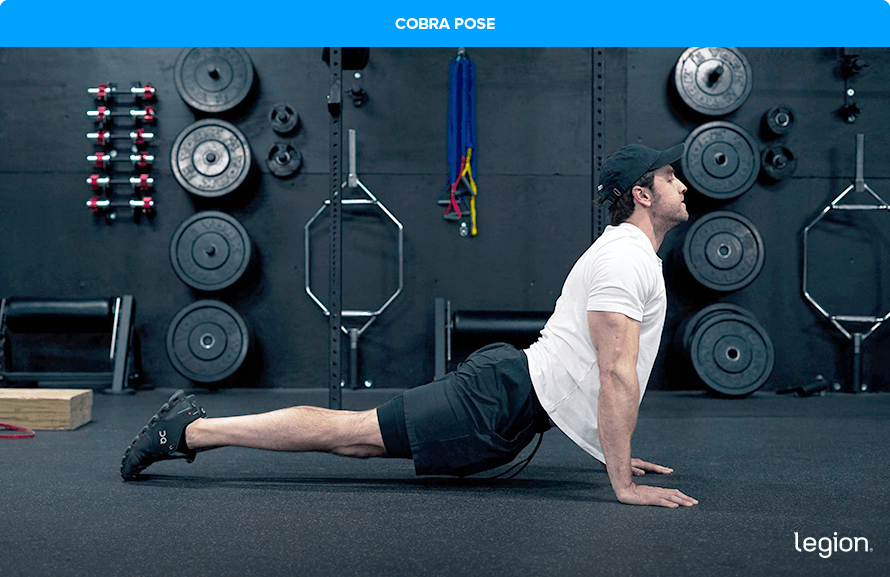
FAQ #7: Does coughing help build abs?
No, coughing won’t build your abs. It involves your core muscles, but not enough to stimulate growth. For that, follow the workouts in this article.
FAQ #8: What body fat percentage do you have to be to see abs?
Men usually begin to see ab definition when they reach 15% body fat, but don’t get clearly visible abs until they’re below 12%. For women, abs begin to show around 24% body fat and become more defined when they get below 20%.
FAQ #9: Does doing front flips get you abs?
No, doing front flips won’t specifically build your abs. While flips require core strength, balance, and coordination, they don’t stimulate growth the way ab exercises do. Moreover, they don’t provide the progressive overload needed for hypertrophy.
Scientific References +
- “SuppVersity EMG Series - Rectus Abdominis, Obliques and Erector Spinae: The Very Best Exercises for Sixpack Abs and a Powerful Midsection - SuppVersity: Nutrition and Exercise Science for Everyone.” SuppVersity EMG Series - Rectus Abdominis, Obliques and Erector Spinae, 28 July 2011, suppversity.blogspot.com/2011/07/suppversity-emg-series-rectus-abdominis.html.
- Sarti, Maria A., et al. “Muscle Activity in Upper and Lower Rectus Abdominus during Abdominal Exercises.” Archives of Physical Medicine and Rehabilitation, vol. 77, no. 12, Dec. 1996, pp. 1293–1297, https://doi.org/10.1016/s0003-9993(96)90195-1. Accessed 16 Dec. 2020.
- Moraes, Antonio C., et al. “EMG Activation of Abdominal Muscles in the Crunch Exercise Performed with Different External Loads.” Physical Therapy in Sport: Official Journal of the Association of Chartered Physiotherapists in Sports Medicine, vol. 10, no. 2, 1 May 2009, pp. 57–62, pubmed.ncbi.nlm.nih.gov/19376473/, https://doi.org/10.1016/j.ptsp.2009.01.001.
- Nina-Margrethe Theodorsen, et al. “Pregnant Women May Exercise Both Abdominal and Pelvic Floor Muscles during Pregnancy without Increasing the Diastasis Recti Abdominis: A Randomised Trial.” Journal of Physiotherapy, 1 Mar. 2024, https://doi.org/10.1016/j.jphys.2024.02.002. Accessed 12 Apr. 2024.
- Rise, Eirin, et al. “Is There Any Association between Abdominal Strength Training before and during Pregnancy and Delivery Outcome? The Norwegian Mother and Child Cohort Study.” Brazilian Journal of Physical Therapy, vol. 23, no. 2, Mar. 2019, pp. 108–115, https://doi.org/10.1016/j.bjpt.2018.06.006. Accessed 21 Apr. 2022.
- Mota, Patrícia, et al. “The Immediate Effects on Inter-Rectus Distance of Abdominal Crunch and Drawing-in Exercises during Pregnancy and the Postpartum Period.” Journal of Orthopaedic & Sports Physical Therapy, vol. 45, no. 10, Oct. 2015, pp. 781–788, https://doi.org/10.2519/jospt.2015.5459.
- Bressel, Eadric, et al. “Effect of Instruction, Surface Stability, and Load Intensity on Trunk Muscle Activity.” Journal of Electromyography and Kinesiology, vol. 19, no. 6, Dec. 2009, pp. e500–e504, https://doi.org/10.1016/j.jelekin.2008.10.006. Accessed 17 Mar. 2022.
- Willardson, Jeffrey M., et al. “Effect of Surface Stability on Core Muscle Activity for Dynamic Resistance Exercises.” International Journal of Sports Physiology and Performance, vol. 4, no. 1, Mar. 2009, pp. 97–109, https://doi.org/10.1123/ijspp.4.1.97. Accessed 13 May 2020.
- Maughan, Ronald J, and Susan M Shirreffs. “Muscle Cramping during Exercise: Causes, Solutions, and Questions Remaining.” Sports Medicine (Auckland, N.Z.), vol. 49, no. 2, 2019, pp. 10.1007/s40279-01901162-1, www.ncbi.nlm.nih.gov/pubmed/31696455, https://doi.org/10.1007/s40279-019-01162-1.










